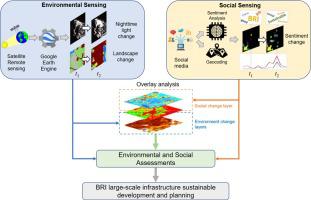Environmental Science & Policy ( IF 4.9 ) Pub Date : 2021-08-05 , DOI: 10.1016/j.envsci.2021.07.020 Yingjie Li 1, 2 , Yuqian Zhang 1, 2 , Leigh Anne Tiffany 2, 3, 4 , Ruishan Chen 5 , Meng Cai 6 , Jianguo Liu 1, 2

|
The booming development of large-scale infrastructure projects (LSIPs) facilitated by China’s Belt and Road Initiative (BRI) has drawn global concern regarding the scale, pace, and potential impact. Studies have largely focused on the geopolitical impact (i.e., politics and international relations) but less is known about social and environmental impact. This is in large part because consistent, high-resolution, cross-boundary social and environmental data at large scales are rather limited. To address the knowledge gap, this research developed a novel Socio-Environmental Sensing (SES) approach by synthesizing remote sensing imagery and geotagged Twitter data to map the socio-environmental impact of LSIPs. We demonstrated the applicability of this approach using two BRI flagship projects, namely, the Mombasa-Nairobi Standard Gauge Railway (SGR) in Kenya and the China-Pakistan Economic Corridor (CPEC) in Pakistan. Our analysis shows that both projects have led to a substantial loss of natural land (e.g., 3.7 % loss of vegetation in Kenya, and 23.3 % reduction of the glacier in Pakistan) but gains in artificial land (e.g., 4.2 % increase in cropland in Kenya, and 34.6 % expansion of built-up land in Pakistan). In addition, the BRI-LSIPs have largely improved local economic development, because nighttime light imagery revealed that regions near the BRI-LSIP sites became much brighter than other regions. Regarding the social aspect, we found that public sentiment toward the projects was largely positive and improved over time, which contradicts the prevalent pessimism to BRI-LSIPs by critics. Nevertheless, sentiment also presented strong spatial heterogeneity – regions around the BRI transportation hubs (usually large cities) most showed more positive sentiment than other regions. By spatially joining the georeferenced sentiment scores with environmental indicators from remote sensing, we further found that positive sentiment improved more in more developed regions, but only changed slightly in other regions. This study provides a novel approach to assess the socio-environmental impact of large-scale projects, and the findings would be useful for informing the implementation of future BRI projects across the globe.











































 京公网安备 11010802027423号
京公网安备 11010802027423号